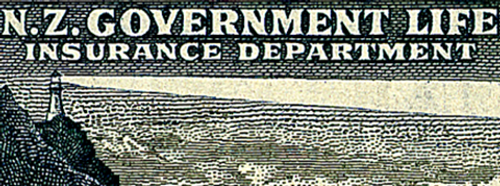
Special stamps for use by the Government Life Insurance Office were first issued in 1891, a lighthouse being incorporated in the original design.
Issue information
The first stamps were issued in the name of the Government Life Insurance Department, but under provisions of the Government Life Insurance Act, 1953, the name was altered to Government Life Insurance Office. The first stamp appearing under the new name was the 2 1/2d Cape Campbell issued on 4 November 1963.
1947 Government Life Stamp Issue again featured lighthouses.
Acknowledgments
New Zealand Post would like to acknowledge the following for their assistance and guidance in bringing together this stamp issue.
Historical Information
Information included on this page sourced from The Postage Stamps of New Zealand published by the Royal Philatelic Society of NZ. Their web site offers further information useful to those interested in the stamps and postal history of New Zealand. Link: https://www.rpsnz.org.nz/
Product Listing for Government Life
| Image | Title | Description | Price |
|---|---|---|---|
 |
Single Stamp |
Single 1/2d 'Castlepoint' gummed stamp. Castlepoint lighthouse, situated on the coast some 30 miles in a straight line east of Masterton, first came into use on 12 January 1913. South of the lighthouse is a prominent hill called The Castle which gives the locality its name. Situated on a peninsula, this light is important for vessels coming from the east which often made Castlepoint their New Zealand landfall. |
1/2d |
 |
Single Stamp |
Single 1d 'Taiaroa' gummed stamp. One of the earliest lighthouses erected in New Zealand, this light came into operation on 2 January 1865. Situated 58 metres above sea level at the southern side and seaward entrance to Otago harbour, the Taiaroa Head Light guided shipping into Port Chalmers, the port city of Dunedin. The tower was built from stone quarried on the site. |
1d |
 |
Single Stamp |
Single 2d 'Cape Palliser' gummed stamp. This light, situated at the southern tip of the North Island, stands guard over the eastern approach to Cook Strait. The light first came into operation on 27 October 1897. |
2d |
 |
Single Stamp |
Single 2 1/2d 'Cape Campbell' gummed stamp. Issued on 4 November 1963: The 22 metre tall Cape Campbell lighthouse guards the south-eastern approach to Cook Strait. Erected originally in 1870 as a timber structure, the tower was rebuilt in steel during 1905 and the lamp electrified in 1938. |
2 1/2d |
 |
Single Stamp |
Single 3d 'Eddystone' gummed stamp. This is the most famous beacon on the British Coast and is situated about 14 kilometres from the Cornish Coast, and 22 kilometres S.S.W. of Plymouth. The first lighthouse erected here was built of timber by Henry Winstanley in 1696 and enlarged and completed in 1699. In a great tempest in 1703 the lighthouse was swept away, carrying with it its hapless architect and five keepers. In 1708 a new lighthouse of stone and wood was erected. Weathering storms for half a century it was eventually destroyed by fire but did become the prototype of all modern lighthouses. A stone lighthouse was built in its place in 1759 which was in turn replaced in 1882 by the lighthouse depicted on the stamp. The tower is 40 metres high with a light visible for 28 kilometres. |
3d |
 |
Single Stamp |
Single 4d 'Stephens Island' gummed stamp. This light positioned to guide shipping passing through Cook Strait, is situated off the northern tip of D'Urville Island and is approximately 96 kilometres in a direct line N.W. of Wellington and about the same distance N.E. of Nelson. It also marks the eastern entrance to Tasman Bay on the north. The powerful light came into operation on 29 January 1894. |
4d |
 |
Single Stamp |
Single 6d 'The Brothers' gummed stamp. The Brothers lighthouse is built on one of a small group of rocky islands off the north coast of the South Island and at the narrowest part of Cook Strait. Built about 70 metres above sea level the light came into operation on 24 September 1877. |
6d |
 |
Single Stamp |
Single 1s 'Cape Brett' gummed stamp. Situated about 32 kilometres due east of Waitangi, Bay of Islands, Cape Brett lighthouse first came into operation on 21 February 1910. It was one of the first of its kind in New Zealand in which the light machinery revolved in a mercury float. The cast iron tower was made in New Zealand, the lantern, machinery and light apparatus being imported from Great Britain. The island depicted on the stamp is Piercy Island. Through this island is a beautiful archway which launches are able to navigate. |
1s |
Technical information
| Date of issue: | 1 August 1947 |
|---|---|
| Designers: | J Berry, Wellington |
| Printer: | Bradbury Wilkinson, England |
| Stamp size: | 1/2d, 1d, 2d and 6d : 37mm x 21mm; 2 1/2d, 3d, 4d and 1s : 21mm x 37mm |
| Sheet size: | 120 stamps per sheet |
| Process: | Recess printed - Intaglio |
| Perforation gauge: | 13.5 |
| Paper type: | St Cuthbert's 'Royal Cypher' grade, multiple NZ and star watermark. |

